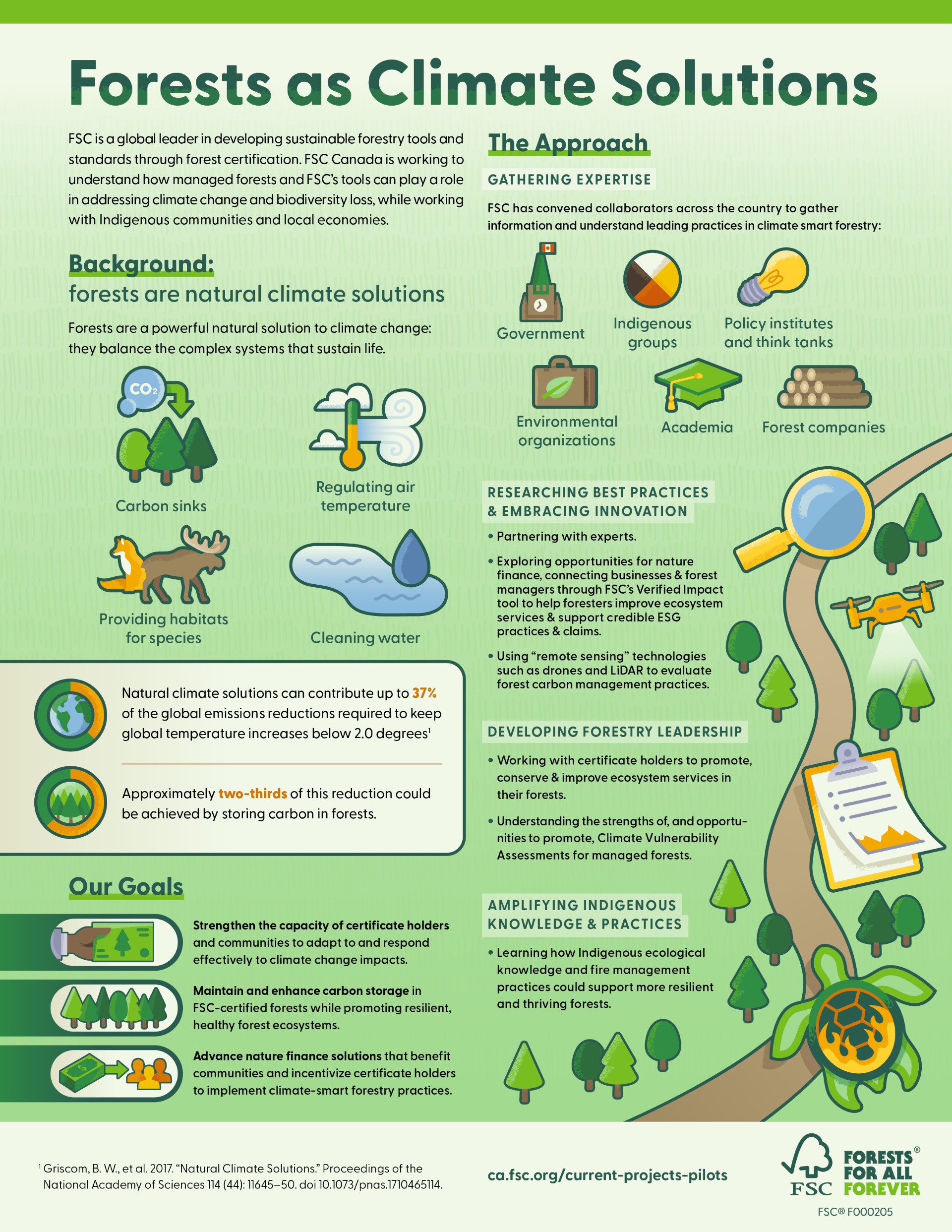
Background
FSC Canada recognizes the pressing need to ensure that forest managers and communities can adapt and become more resilient to a changing climate, as well as to support climate change mitigation through carbon and biodiversity management.
To support this, FSC Canada launched the Climate and Landscape Solutions program area in 2023, which focuses on:
- Building the capacity of Canadian managed forests to adapt to our changing climate
- Advancing biodiversity and climate solutions across forests and communities
- Unlocking nature finance opportunities, enhancing available funds for conservation and climate-smart forest management.
Nature finance is a rapidly growing and evolving field looking at ways that financial market mechanisms can be used to incentivize climate action and contribute to the goal of halting and reversing nature loss.
At the same time, the Government of Canada has been working to implement ‘30x30’ - a commitment to protect 30 percent of Canadian lands and waters by 2030, in alignment with commitments under the UN Global Biodiversity Framework. The potential for areas with high conservation value within FSC-certified forests to meet the criteria to support Canada's 30 x 30 goals became clear.
As a result, FSC Canada was awarded funding from ECCC to run two projects to determine how managed forests can contribute to Canada’s climate and biodiversity targets.
Learn more about each of these projects and opportunities to get involved, below.

Project One | Forests as Climate Solutions
The first project, Forests as Climate Solutions (FaCS), explores how forest management practices can help ensure forests are more resilient in the face of a changing climate.
In particular, the project will focus on:
- how forest managers can better prepare for and manage for the impacts of climate change, and
- how greenhouse gases can be reduced through carbon and fire management.
This project includes dedicated pilots to implement, test and measure best practices, tools and methodologies for fire and carbon management.
This includes working with Indigenous communities and forest managers to better understand Indigenous land management practices and Traditional Knowledge that will inform a holistic understanding of approaches to enhancing the resilience of forests and the communities that steward them.

Project Two | Other Effective area-based Conservation Measures
The second project looks at how conservation areas in FSC-certified forests could contribute to Canada’s 30 x 30 target, through designation as Other Effective area-based Conservation Measures (OECMs). OECM recognition provides formal acknowledgment of forest managers’ work to identify and protect areas with high biodiversity value and opens pathways to connect with nature finance opportunities.
Find out more about each project, and how you can get involved, below.


Project One | Forests as Climate Solutions
Climate responses in FSC certified forests: building resilience and reducing GHG emissions
The three-year, ECCC-funded FaCS project explores the tools and methodologies available to support climate adaptation and carbon management in managed forests, including the role of standards in optimizing the capacity of forests to act as nature-based solutions to climate change.
As well, the project looks at opportunities to unlock the value in responsible forest management for both FSC certificate holders and businesses, using innovative nature finance mechanisms to fund this important work. FSC's Verified Impact tool connects sustainability-oriented companies with forest managers, helping fund conservation efforts and supporting companies to obtain high-quality forest impact data that enables them to prove and progress their climate and biodiversity goals and meet regulatory requirements.
The project aims to explore four key areas of opportunity:
- Enhance climate resilience by reducing risks posed by climate change to ecosystems and communities.
- Improve the adaptive capacity of certificate holders and communities, enabling them to better respond to climate change and meet evolving FSC standards.
- Reduce greenhouse gas emissions by maintaining and protecting stored carbon in FSC-certified forests.
- Incentivize climate action by accessing market mechanisms that support and reward certificate holders for adopting climate-positive practices.
Outputs from these explorations will lead to ways to strengthen FSC Canada’s existing tools and guidance as it relates to forest management standards, as well as leveraging nature finance, using its novel Verified Impact offering to fully value and incentivize investment for measurable climate and biodiversity benefits.
The project builds on existing requirements that uphold the rights of Indigenous Peoples and proposes partnering with Indigenous communities, integrating Traditional Ecological Knowledge and practices to establish thriving forests and communities.
With forests across the country at increasing risk from climate change, the Forests as Climate Solutions project will help ensure a resilient forestry industry through enhanced management practices while progressing Canada’s conservation and climate goals.
Learn More and Get Involved
FSC Canada is actively seeking forest management companies, communities and Indigenous groups who may be interested in participating in carbon and fire management pilots. This is a unique opportunity to contribute to FSC standard development and advance forestry management practices. Funding is available to select participants.
To find out more about getting involved in a carbon or fire management pilot program, contact Amy Willox: amy.willox@ca.fsc.org.
To find out about climate and landscape solutions, contact Vivian Peachey: v.peachey@ca.fsc.org

Project Two | Conserving Biodiversity in Managed Forests
Other Effective Area-Based Conservation Measures
Canada, along with 195 other countries, has agreed to a set of targets intended to halt and reverse the loss of biodiversity globally. The 23 targets are described in the Global Biodiversity Framework, which was agreed to in 2022 in Montreal.
Several of these targets are relevant to sustainable forestry, including Target 3, a commitment to protect 30% of lands and waters by 2030, commonly known as “30 x 30”.
Protection can be in the form of formal protected areas, like provincial or national parks or ecological land trust properties. OECMs can also contribute to 30 x 30.
The OECM label is a recognition or acknowledgment of legal, policy, and other mechanisms that define the way an area is managed for the long term. Having an area recognized as an OECM does not confer new status to it, but does raise the profile of its value to biodiversity.
OECMs in Canadian Managed Forests
The ECCC-funded Other Effective Area-based Conservation Measures (OECM) project will explore pathways for identifying and reporting OECMs in FSC-certified forests, using the existing framework of the FSC system.
FSC is collaborating with provincial bodies to co-develop solutions to help managed forests contribute to the Global Biodiversity Framework Target 3 and Target 10 (sustainable use of biodiversity). We will do so by identifying the opportunities that already exist within our standards and guidance that align with provincial, pan-Canadian, and international guidelines for identifying OECMs, and by proactively co-developing the tools that will be required to manage risk.
This initiative involves broad stakeholder engagement, research, Indigenous engagement, piloting, and outcome monitoring to ensure comprehensive support for biodiversity and climate goals, supporting the conservation claims of forest managers.
We are proudly collaborating on this work with Ontario Nature.
Learn more about OECMs in Canadian Managed Forests. Check out our FAQs below.
For more information, contact Vivian Peachey: v.peachey@ca.fsc.org

